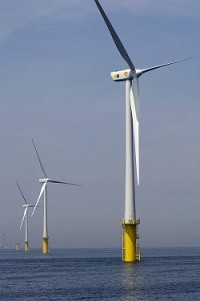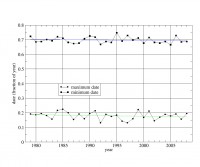By Danny Fortson< Sunday Times
ROYAL DUTCH SHELL has become the second big energy company to abandon the UK wind-energy sector in the last month.
Shell, Danish firm Dong Energy and Scottish Power have cancelled the 800m UKpound Cirrus Array project off the northwest coast after five years and millions of pounds in investment. The consortium blamed Ministry of Defence concerns over radar interference from turbines.
Less than a month ago, Shell denied a Sunday Times report that it had exited the project. However, on Friday the company confirmed that it had no plans for further investment in the UK wind sector. Shell said: “The focus for new projects will be in North America where we can benefit from the availability of undeveloped wind resources to deliver wind energy at what we expect to be a competitive cost.” Last month BP also moved its wind-energy focus to America, citing generous subsidies and a less-onerous planning process.

Read more here.
And in the Sunday Telegraph, they report Wind Power Targets Unrealistic. A report by the Committee on Climate Change (CCC), published last week, maintained that wind farms could play a major role in helping Britain cut its harmful carbon emissions by 34 per cent in 2020 and 80 per cent by 2050.
It stated: “Despite the inherent intermittency of wind power supply, wind generation could make a significant contribution to total global electricity generation and be a major source of electricity in the UK (eg 30 per cent by 2020 and more beyond).” The CCC, chaired by Lord Turner, the former director general of the Confederation of British Industry, said that new techniques of energy storage would overcome the problem of maintaining a regular supply when the wind is not blowing.
But sceptics say this is far too ambitious because experts have not yet been able to devise effective ways of capturing and storing electricity generated by wind. That means a backup system, in the form of nuclear or coal- or gas-fired power stations, would always be needed. John Constable, director of policy and research at the Renewable Energy Foundation, a think tank, said: “To generate 30 or 40 per cent of our electrical energy from wind power would present unmanageable and unaffordable difficulties at the present.
“The CCC’s assertion to the contrary is simply out of step with the state of theoretical and empirical knowledge in the field. Betting on very heavy commitment to wind for carbon reduction is irrational and will result in the inevitable failure of our climate change policy. Wind has a role, but this role will be modest in scale.” Read more here.
By Roger Pielke Sr., Climate Science
The use of Arctic sea ice coverage as a climate metric has received wide science and media coverage. This issue is motivated by the recent large reduction in late summer areal coverage (e.g. see the data on the excellent website The Cryosphere Today).
There is another sea ice metric to look at, however, and that is the date of the year of the minimum and maximum sea ice coverage. With the addition of well-mixed greenhouse gases into the atmosphere, we should expect the start of the freeze-up in the late summer/early fall to be later and the start of the melt in the late winter/early spring to be earlier.
Indeed, this is what is claimed in a recent talk by Mark C Serreze of the Cooperative Institute for Research in Environmental Sciences/National Snow and Ice Data Center (CIRES/NSIDC) at the University of Colorado Boulder (November 10 2008 - titled “The Emergence of Arctic Amplification"), where his abstract reads:"The concept of Arctic amplification is that rises in surface air temperature in response to increasing atmospheric greenhouse gas concentrations will be larger in the Arctic compared to the Northern Hemisphere as a whole. Model-projected Arctic amplification is focused over the Arctic Ocean. As the climate warms, the summer melt season lengthens and intensifies, leading to less sea ice at summer’s end. Summertime absorption of solar energy in expanding open water areas increases the sensible heat content of the ocean. Ice formation in autumn and winter, important for insulating the warm ocean from the cooling atmosphere is delayed.”
The abstact includes the statement “As the climate warms, the summer melt season lengthens” In order to explore this issue further William Chapman, author of The Cryosphere Today website, graciously prepared an analysis of the dates of the minimum and maximum Arctic sea ice coverage since 1979. The plot of this data and the individual values in fraction of the year are presented below.

See larger size image here
The finding in this data is that there is no clear evidence of a delay in the start of the later summer/early fall freeze up or the start of the late winter/early spring melt despite the well below average areal sea ice coverage.
A priority in the climate modeling community should be an examination of their predictions of trends in the start of freeze up and start of melt dates, in order to see how they conform to the observational data. Also, the reason that the added atmospheric concentrations of well-mixed greenhouse gases are not changing the dates as expected needs to be provided. Read full post here.
Investors Business Daily
Stimulating the economy with massive new investments in “green” infrastructure seems to be a popular idea, and President-elect Obama has made it a centerpiece of his program. Will it work? We doubt it. Both Obama and congressional Democrats believe we can move to a new carbon-free future by “investing” in “green” technologies and infrastructure, while creating millions of new jobs.
As it stands, Obama is eyeing $100 billion in “green stimulus” as part of a much bigger package - as much as $700 billion or more - of conventional stimulus. He reckons this will create up to five million “green-collar jobs” and “jolt” the economy back to life. “Clean energy is going to be a foundation for rebuilding the American economy,” says Bracken Hendricks of the liberal Center for American Progress and a member of Obama’s transition team.
How will the money be spent? “School repairs,” according to a Bloomberg report, “could be required to meet green building standards, including low-energy boilers and weatherization. Transportation spending could emphasize public transit, and support for new power sources such as wind . . . could go hand in hand with spending on an efficient electricity superhighway.”
Sounds great. But it’ll take money - plus new regulations that will make it more expensive to do anything with oil, even if there are no reasonable alternatives. Nowhere is it mentioned that these “green-collar jobs” would be terribly costly, and that the planned “investments” are really just subsidies. And, as we know, things that require subsidies aren’t competitive in the market, and thus aren’t profitable. Claims that such “investments” will create five million jobs are false. It’s likely more jobs will be killed than created due to higher costs and increased inefficiency of the U.S. economy. A recent report from the Center for Data Analysis at the Heritage Foundation found that limiting CO2 emissions under recent proposed legislation would destroy 900,000
net jobs.
Spending money on projects where costs exceed benefits simply to “create jobs” is a bad idea. Taking capital from productive uses and redeploying it to politically popular but nonproductive uses lowers productivity by paying those with “green jobs” more than their output is worth. It’s not welfare, it’s “greenfare.” This, by the way, was the make-work model followed during the Great Depression. It didn’t work then, and it won’t work now. These ideas aren’t new - they were thoroughly debunked 158 years ago by pioneering French economist Frederic Bastiat, who wrote about the “broken window fallacy.”
It goes like this: Most people agree that when someone breaks a store window, it’s a tragedy for the shopkeeper. But many also believe the overall economy actually benefits, because the shopkeeper now must buy a new window, a kind of “stimulus.” This logic, of course, makes no sense. Yet it’s the basic idea behind all government stimulus plans. The money for the window comes out of the shopkeeper’s pocket. Instead of carrying more stock in his store, or hiring a clerk, he must spend his money instead on a window. So the “stimulus” is really zero - or negative. “The ‘broken windows’ in this case,” notes American Enterprise Institute analyst Kenneth Green, “would be lost jobs and lost capital in the coal, oil, gas, nuclear and automobile industries.” They together employ more than 1 million people. But millions of other jobs would also be at risk because, as with the shopkeeper, money spent on green projects can’t be spent elsewhere. What was true in Bastiat’s time is certainly true today. The weak productivity report Wednesday, showing a tepid 1.3% gain in nonfarm output per hour, should be warning enough. See report here.


